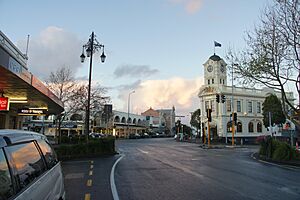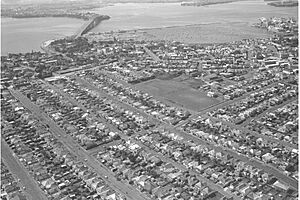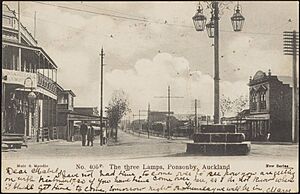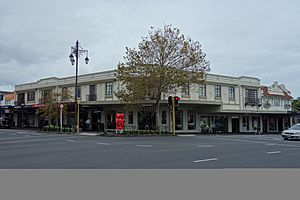Ponsonby, New Zealand facts for kids
Quick facts for kids
Ponsonby
|
|
|---|---|
|
Suburb
|
|

The Three Lamps area in Ponsonby, with the Ponsonby Post Office and Leys Institute visible
|
|
| Country | New Zealand |
| Local authority | Auckland |
| Electoral ward | Waitematā and Gulf ward |
| Local board | Waitematā Local Board |
| Established | 1845 (approx.) |
| Area | |
| • Land | 135 ha (334 acre) |
| Population
(June 2023)
|
|
| • Total | 5,440 |
Ponsonby (also known as Te Rimu Tahi in Māori) is a lively suburb in Auckland, New Zealand. It's located about 2 kilometers west of the city center. The main street, Ponsonby Road, runs along a ridge (a long, narrow hill).
Ponsonby used to be a neighborhood for working-class families. But since the 1970s, it has changed a lot. More people with higher incomes have moved in, making it a popular and trendy place to live.
Three Lamps is a well-known spot in Ponsonby. It's where Ponsonby Road, College Hill, and St Marys Road meet. This name comes from an old lamppost that stood there a long time ago.
Contents
What's in a Name?
The area we now call Three Lamps was first named Dedwood in 1845. This name came from a farm nearby.
The name Ponsonby came later, in 1873. It was likely named after Ponsonby Road, which appeared on maps as early as 1860.
There are a few famous people who might have inspired the name Ponsonby:
- Major-General Sir Henry Ponsonby: He was a private secretary to Queen Victoria from 1870 to 1895.
- The Honourable Ponsonby Peacocke: He was a member of the New Zealand Legislative Council and lived on Ponsonby Road in the 1860s.
- Major-General Sir Frederick Ponsonby: A brave cavalry leader in the Napoleonic Wars. He was also the Governor of Malta.
- Major-General Sir William Ponsonby: Another cavalry leader who sadly died at the Battle of Waterloo.
The Māori name for the ridge where Ponsonby is located is Te Rimu Tahi. This means 'The Lone Rimu Tree'. It refers to a very old, tall rimu tree that people say once stood at the crossing of Ponsonby Road and Karangahape Road.
Ponsonby's Past
Māori people settled in the Auckland area a long time ago. By the 1400s, they had fishing and gardening spots all around. In Ponsonby, there was a special place to gather 'Kuta' (a type of plant) near the Waikuta Stream.
In 1840, a large area of land, including what would become Ponsonby, was given to Governor William Hobson. This land was meant to be the new capital of New Zealand. Ponsonby started to grow with homes in the 1840s and 1850s. Sawmills and shipyards provided jobs for the people living there.
In 1853, Bishop Pompallier bought a large piece of land. This led to many Catholic families moving to the area. Schools and churches were built, like St Mary's College and the Church of the Immaculate Conception. The Bishop Pompallier House became a school for Māori girls. Many street names in Ponsonby, like Pompallier Terrace and Dublin Street, show the area's Irish and Catholic history.
In the 1870s, more houses were built as Auckland's population grew. In 1873, the name of the area officially changed from Dedwood to Ponsonby. In 1884, the first horse-drawn trams started running from Queen Street to Ponsonby. These were later replaced by electric trams in 1902. This made Ponsonby even more popular for homes and businesses.
Around the early 1900s, Ponsonby became quite crowded. In 1917, the Victoria Park Market-City Destructor was built to help manage rubbish. It later generated electricity for Auckland, providing the city's first public power supply. During World War II, Victoria Park was used as an American army camp.
From the 1940s to the 1970s, many Pacific Islanders came to New Zealand and settled in Auckland, especially in Ponsonby. In the 1950s and 1960s, some people moved to newer suburbs. Also, the city council cleared some older homes, and a motorway was built nearby. These changes led to lower rents in Ponsonby.
In the 1970s, Ponsonby became a hub for artists and different community groups. It was known as the birthplace of New Zealand Reggae music. In 1971, the Polynesian Panthers, a group working for social justice, were formed in Ponsonby. From 1973 to 1979, many Pacific families faced difficult times during the Dawn Raids. These were immigration checks that mostly affected Pacific Islanders. As fuel prices rose, living closer to the city became more popular, and rising rents made it harder for some families to stay in Ponsonby.
In 1979, the first mosque in New Zealand began construction in Ponsonby. In 1983, the Victoria Park Market opened in the old destructor buildings.
Since 1992, Franklin Road in Ponsonby has been famous for its amazing Christmas lights display. Over 100 houses decorate their homes for everyone to enjoy for free each year.
In 1996, the Hero Parade, a celebration of diversity, moved to Ponsonby Road. The Auckland Pride Festival Parade also returned to Ponsonby in 2013.
The Three Lamps Spot
Three Lamps is a specific area in Ponsonby. It's where Ponsonby Road, St Marys Road, Jervois Road, and College Hill all meet. The name comes from a special lamp that used to stand right in the middle of this intersection.
The original lamp was taken away in the 1930s because it was a traffic hazard. However, a new replica lamp was placed on the footpath in 2012, bringing the name back to life.
Famous Buildings and Places
Ponsonby has many historic and interesting buildings:
- St John's Church, Ponsonby: This Methodist church was built in 1882 on Ponsonby Road. It's a protected heritage building.
- St Mary's Old Convent Chapel: Built in 1866, this chapel is a very important heritage building.
- St Stephens Church, Ponsonby: A Presbyterian church built in 1879.
- The Ponsonby Baptist Church: This church was started in 1875, and its current building was put up in 1905. Both the old and new buildings are important heritage sites.
- The Bishop's House: Built in 1893–1894, this building is part of the Catholic Diocese of Auckland and is a protected heritage site.
- The Ponsonby Fire Station: Built in 1902, this old fire station is also a protected building.
- The Ponsonby Post Office: Constructed in 1912, this post office has a grand design and is a significant heritage building.
- The Auckland Savings Bank building: Built in 1928, this is another protected heritage building.
- The Gluepot Tavern: This building was a hotel in the 1930s with a cool art deco style. It's now apartments, shops, and offices, but its original look has been kept.
- The Leys Institute: This includes a gym and a public library, built in 1905–1906. Both buildings are important heritage sites.
- The Britannia Theatre: First a skating rink in 1905, it became a movie theater by 1910. It closed in 1969 and is now a shopping area called Three Lamps Plaza.
- Renall Street: This whole street is a historic area. All the houses on it are from the Victorian era and show how homes for different income levels were built back then.
- The Auckland Unitarian Church: Built in 1901, this was the first Unitarian church in New Zealand and is a protected heritage site.
Ponsonby's People
Ponsonby covers about 1.35 square kilometers. As of 2023, it has an estimated population of about 5,286 people.
In the 2023 census, Ponsonby's population was 5,286. Most people in Ponsonby are of European (Pākehā) background (83.0%). There are also people who identify as Māori (9.8%), Pasifika (8.9%), and Asian (9.4%). About 7.6% of people identified as LGBTIQ+.
English is spoken by most people (97.7%). Other languages like Māori and Samoan are also spoken. Many people in Ponsonby have university degrees. The median income in Ponsonby is higher than the national average.
Learning in Ponsonby
Ponsonby has several schools for different age groups:
- St Paul's College: A Catholic secondary school for boys (Years 7–13) with about 51 students.
- Marist School: A Catholic primary school (Years 1–6) for both boys and girls, with about 1360 students. It shares the same site as St Paul's College.
- Ponsonby Intermediate: An intermediate school (Years 7–8) for both boys and girls, with about 1445 students.
- Richmond Road School: A primary school (Years 1–6) for both boys and girls, with about 1463 students.
Famous Faces from Ponsonby
Many well-known people have lived in Ponsonby:
- Ella Yelich-O'Connor/Lorde: A world-famous singer and songwriter.
- Peter Burling: A champion sailor.
- Karen Walker: A famous designer.
- Michael Joseph Savage: A former Labour Prime Minister of New Zealand.
- Peter Fraser: Another former Prime Minister.
- Helen Clark: A former Labour Prime Minister.
- Amey Daldy: An important feminist who helped women get the right to vote in 1893.
- Freda Stark: A famous performer and dancer.
Sports in Ponsonby
Ponsonby is home to two well-known sports clubs:
- The Ponsonby Ponies: A rugby league club.
- The Ponsonby Rugby Football Club: A rugby union club.
|








